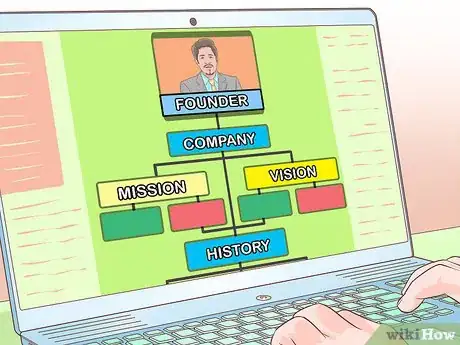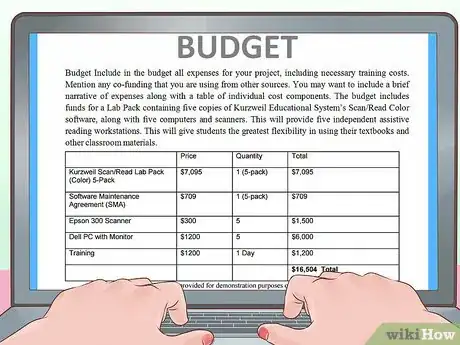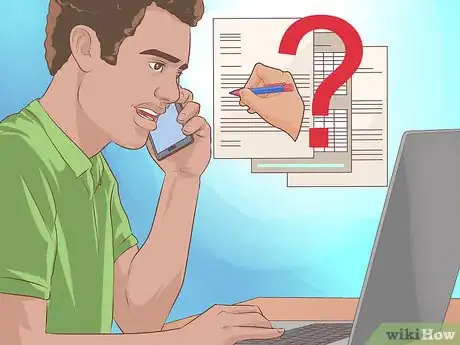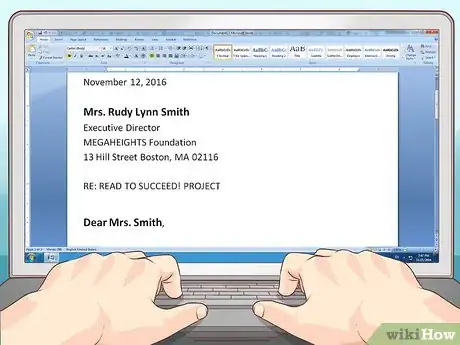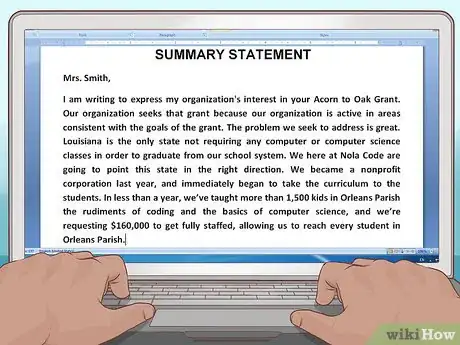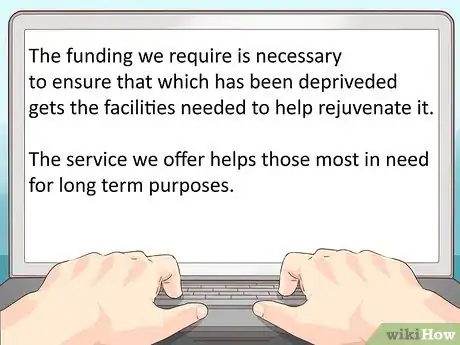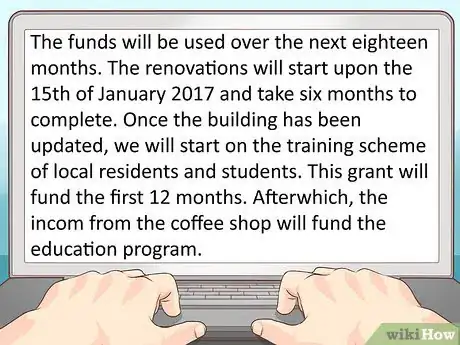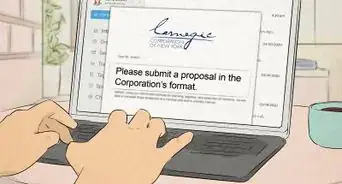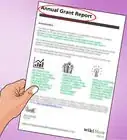This article was co-authored by wikiHow Staff. Our trained team of editors and researchers validate articles for accuracy and comprehensiveness. wikiHow's Content Management Team carefully monitors the work from our editorial staff to ensure that each article is backed by trusted research and meets our high quality standards.
wikiHow marks an article as reader-approved once it receives enough positive feedback. In this case, 92% of readers who voted found the article helpful, earning it our reader-approved status.
This article has been viewed 100,716 times.
Learn more...
A letter of interest (LOI) is an introductory document expressing an individual or organization's desire to receive grant funding from another organization or foundation. Preceding a full proposal, the letter of interest is meant to gauge whether the foundation is interested in funding the proposed project. Usually two to three pages in length, a letter of interest must include important details about the project and convince the granting foundation of its importance.
Steps
Laying the Foundation for Success
-
1Know your audience. Learn everything you can about the foundation making the grant. Find out what types of philanthropy the foundation has engaged in before, and learn about the foundation’s history and its milestones so you can think of the ways your vision is consistent with theirs.[1]
- It’s not always easy to learn much about a non-local foundation, so try some unconventional tactics, like reading their press releases and searching their Form 990 filings (tax forms). You can look for 990s at http://990finder.foundationcenter.org/.
-
2Get started on your proposal. Writing the proposal concurrently with the letter of inquiry doesn't harm the proposal and only helps the letter of inquiry. Even though your proposal will be modified according to the grant you're applying for, the broad outlines should remain the same.[2]
- The details you learn from conducting the research and writing for your proposal should help you design a more effective pitch in the letter of inquiry. Knowing those details makes you seem more competent and knowledgeable.
Advertisement -
3Think about what the grant is funding in concrete terms. Your organization or academic department may benefit quite a bit if you are awarded the grant. Even though the department or organization as a whole will benefit, most foundations don't want to write a check for general operating expenses. Instead, they want to be able to point to something specific that their grant accomplished.
- Think in terms of a building constructed, a study completed, a program launched, or services rendered. While your complete proposal will include a detailed budget, you should explain any major shortfalls in funding. For example, if you're applying for a $15,000 grant and it's supposed to help build a clinic, the foundation will want to know where the rest of the money will come from.
Writing Your Letter
-
1Review all instructions or guidelines for submitting a letter of interest. Instructions with respect to length, format, and content may vary by philanthropic organization, and they need to all be followed exactly. You never want to be disqualified because of a technicality.[3]
- Most foundations will specify their preferred format when they issue the request for letters of inquiry. If they don't, check their website, email, or call them to make sure there aren't any special guidelines you need to follow.
-
2Address your letter to the foundation's grant reviewer. Most of the larger foundations will have instructions on their website specifying to whom you should send you letter of inquiry. If you are applying to a smaller foundation, just call them up or send them an email asking who you should address the letter of inquiry to.[4]
- Don’t let your letter stick out for the wrong reasons. Use conventional salutations and honorifics. “Ms. Smith,” rather than “Mrs. Rudy Lynn Smith” is the way to go. Include an address block with full details about street address, name, and position.
-
3Begin your letter with a summary statement. The first paragraph of your letter of inquiry should be able to stand independently of the rest of your letter. Your summary statement should introduce yourself or your organization, describe the problem, your position on the problem, how you would fix it, how much money you need to fix it, and how long you would need it for.[5]
- For example, “Mrs. Smith, I am writing to express my organization's interest in your Acorn to Oak Grant. Our organization seeks that grant because our organization is active in areas consistent with the goals of the grant. The problem we seek to address is great. Louisiana is the only state not requiring any computer or computer science classes in order to graduate from our school system. We here at Nola Code are going to point this state in the right direction. We became a nonprofit corporation last year, and immediately began to take the curriculum to the students. In less than a year, we’ve taught more than 1,500 kids in Orleans Parish the rudiments of coding and the basics of computer science, and we’re requesting $160,000 to get fully staffed, allowing us to reach every student in Orleans Parish.”
- Be specific. After reading the first paragraph, the benefactor should have no doubt about exactly when, where, and how the money will be used.
-
4Follow up your summary with a description of the organization. People are drawn to narrative, so without going on too much of a detour, tell them the story of your organization. Be sure to work in descriptions of your mission, history and past accomplishments, including completed projects and recognition and awards.[6]
- For example, you may want to explain to the reviewers how you as a leader became involved personally involved. Whether it was you and a few others who began as a group of volunteers, or you were drawn to your organization's work as an outsider, bring a little personal touch to the organization's story.
- In addition to familiarizing the foundation with your organization's work, this section should convince the people responsible for grant funding that you are capable of completing the project. In the interests of establishing credibility, identify other grants you've received and explain what they accomplished.
-
5Explain why the nonprofit should help this specific community or area of study. Your statement of need should focus on the community you are impacting, not only on your own organization's financial needs. You should already have convinced the foundation that you are capable of using their funds to see your project through; now, you need to convince them that there is a real need for such a project. [7]
- This paragraph is telling about the story of the area. With Nola Code, that story would begin with Hurricane Katrina, the mass layoffs and reorganization of the school system, and the inconsistent types of instruction given thereafter. The genesis of the organization is consistent with the ersatz rebuilding process that remade the city.
-
6Give your audience a timeline for your project. This section is intended to expand upon the details in the first paragraph and to showcase your grasp of the technical or logistical considerations involved with your project.[8]
- Basically, this section just needs to sound like a plausible plan told by a plausible person. For the Nola Code example, it could be the benchmarks of having all the new staff hired in 90 days, and then trained within 120 days, so they can get to work as soon as possible.
- If you have written or will write another grant proposal, list the other foundations to which you are applying. If there are aspects of the project which would not be covered by the grant for which you are expressing interest, indicate the costs of those other aspects and how you will pay them.
-
7Conclude by summarizing your project and your financial need. As with any strong conclusion, start with a very specific point—an anecdote about the first kid taught by Nola Code and its effect on his life—and make the paragraph more general as it continues, finally making a larger point about the world.[9]
- As a last word, indicate that you would like to submit a full grant proposal in the near future.
References
- ↑ https://www.umass.edu/cfr/grant-writing/guidelines-letter-intent
- ↑ https://www.umass.edu/cfr/grant-writing/guidelines-letter-intent
- ↑ http://sofii.org/article/writing-letters-of-interest-to-get-that-important-grant
- ↑ https://www.umass.edu/cfr/grant-writing/guidelines-letter-intent
- ↑ https://www.umass.edu/cfr/grant-writing/guidelines-letter-intent
- ↑ https://www.thebalance.com/how-to-write-a-letter-of-inquiry-loi-to-a-foundation-2501958
- ↑ https://www.umass.edu/cfr/grant-writing/guidelines-letter-intent
- ↑ http://grantspace.org/tools/knowledge-base/Funding-Research/proposal-writing/letters-of-inquiry
- ↑ https://www.thebalance.com/how-to-write-a-letter-of-inquiry-loi-to-a-foundation-2501958
